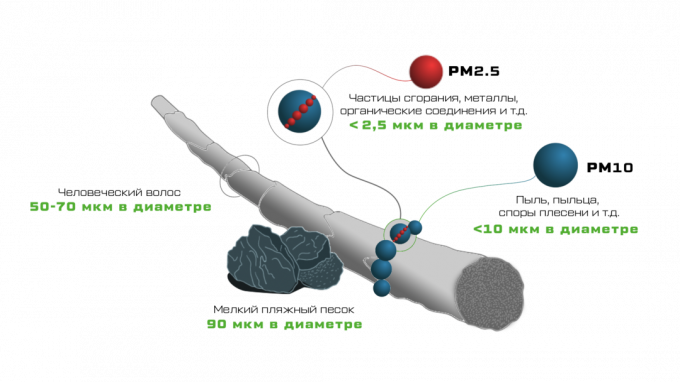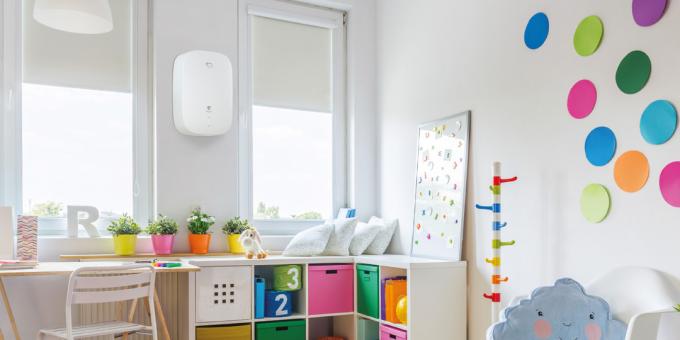What's wrong with the air in cities
According to the World Health Organization, 91% of the world's population livesAir pollution in areas with polluted air. In big cities, industrial enterprises are the main reasons for this.Commercial and Industrial and transportTransportation - they emit nitrogen dioxide, carbon monoxide and carbon dioxide into the atmosphere. In addition to gaseous impurities, there are pollutantsHealth effects of particulate matter in the form of small solid particles and tiny liquid droplets. In the city, these can be products of fuel combustion, dust from construction sites and elements of the road surface - while driving, cars wash tires and asphalt, and as a result, all this gets into the air.
Such particles are usually separatedParticulate Matter (PM) Basics into two types: the size of large (PM10) is up to 10 microns, small (PM2.5) - up to 2.5 microns. Large elements are annoyingParticle Pollution eyes and respiratory tract, and small ones penetrate deep into the lungs and enter the blood.

Inhalation of such particles can provokeHealth Risks of Particle Pollution asthma attacks, and in the long term increases the risk of developing cardiovascular, respiratory and oncological diseases. At risk are children, the elderly, pregnant women, as well as people who have heart or respiratory problems.
If you open a window to ventilate the room, dirt and dust from the street will enter the apartment, and along with them, allergens (for example, plant pollen), unpleasant odors and noise will enter the room. The usual airing has other disadvantages. So, in winter with open windows or vents there is a risk of hypothermia, freezing from the icy air from the street indoor plants, and the condensation formed on the glasses will drain onto the windowsill - this can lead to the appearance mold.
However, fresh air is indispensable - the concentration of pollutants in the room isIndoor Air Quality two to five times higher than on the street. This is due to tobacco smokeSecondhand Smoke and Smoke ‑ free Homes, chipboard furniture that can emitWhat should I know about formaldehyde and indoor air quality? formaldehyde, household chemicalsVolatile Organic Compounds' Impact on Indoor Air Quality, moldCare for Your Air: A Guide to Indoor Air Quality, dust, hair and skin particles of pets. Household appliances are another source of pollutionGas stoves making indoor air up to five times dirtier than outdoor air, report finds: For example, when cooking on a gas stove, gas combustion products accumulate in the air.
What to do to breathe easier
First, get rid of the main sources of pollution. Do not store old chipboard furniture at home, and even more so do not buy new ones, if possible, give up aerosolsVolatile Organic Compounds' Impact on Indoor Air Quality - for example, hair styling products or air fresheners. Use household chemicals strictly according to the instructions - some formulations can be used only in well-ventilated rooms.
Dust and mop regularly - this should be doneHow Often Should You Clean This? at least once a week. But be careful with indoor plants: there is no convincing dataImproving Indoor Air Qualitythat they really help purify the air, but due to abundant watering, microorganisms that are dangerous for allergy sufferers can multiply in the soil. Stop smoking, or at least do not smoke in the room. Airborne volatiles can be up to twice as high in smoking areasSmoking out sources of in-home air pollutionthan where smokers are prohibited from entering.
The optimal solution for supplying fresh, oxygenated air and cleaning indoor air is the installation of a supply ventilation system. It will fill the room with fresh, clean air even with the windows closed, remove harmful impurities from it, and, if necessary, also warm it up so that the house does not get cold.
The compact complex is suitable for premises up to 37 m² BREZZA XS RCB 75. For apartments up to 75 m², choose the model BREZZA RCB 150, which delivers up to 150 m³ of air per hour.
I want to breathe fresh air
How are the supply and purification complexes
Multi-stage air purification
Before entering the apartment, the air passes through a filter system. They trap dirt and gaseous compounds and also protect against PM2.5 fine particles. Model BREZZA XS RCB 75 there is a three-stage air treatment: filters of preliminary and fine cleaning are not allowed into dust and other small impurities, and the charcoal filter removes exhaust gases and unpleasant odors.
BREZZA RCB 150 has a five-step system of action. In addition to filters for preliminary and fine cleaning, as well as a carbon element, the complex is equipped with HEPA ‑ ultrafine filter, which helps to fight the smallest pollutants, and an ionizer, which saturates the air with beneficial air ions.
The fine filter and charcoal filter do not need to be replaced within 6-12 months, and the HEPA service life is 1-2 years. They need to be cleaned once a month with a conventional vacuum cleaner and the pre-filter can be rinsed with water.

Operating modes for any conditions
With the help of supply and purification complexes BREZZA you can breathe clean air all year round 24 hours a day. The BREZZA XS RCB 75 has supply, night and intelligent modes, and the fan operates at three speeds. The BREZZA RCB 150 additionally has a recirculation function and ECO mode in combination with six fan speeds. This allows you to adjust the required performance of the complex - you can, for example, enable the fan at maximum to quickly ventilate the apartment, or leave it at a low speed so as not to noise interfered.
In the night mode, the complex operates with minimal performance and does not disturb even a light sleep. The noise level is 20 dBA - for comparison, for a whisper it isWhat Noises Cause Hearing Loss? 20-30 dBA. Intelligent mode allows you to monitor the temperature in the room and the concentration of PM2.5 particles, and, if necessary, increases the productivity of the complex. By the way, you can find out the level of air pollution using the display on the remote control or the indicator on the front panel of the device itself.
If it is cold outside, BREZZA complexes will warm up the air before supplying it to the room. Heating range - from -40 ° С to +30 ° С.

When the temperature outside the window drops below -40 ° C, the recirculation mode is automatically activated - the system does not supply air from the street, but cleans the air that is already in the room. Recirculation can also be used when there are allergy sufferers at home, so there is less dust in the room. This mode is also useful for owners of pets with too much hair.

Ideal to pair with conditioner
Contrary to popular misconception, traditional split-systems do not supply air from the street into the room, but only cool the air that is already in the room. It seems as if it is getting fresher, but in reality the level of carbon dioxide remains the same. In a sealed apartment, there is simply nowhere to get oxygenated air. In addition, if you do not clean the air conditioner filter, it can turn into an additional source of pollution.
So you need to ventilate in any case. And complexes will help solve this problem BREZZA. They will ensure the flow of clean air, and the air conditioner will cool it down to a comfortable temperature.
Simple assembly
There is no need to undertake large-scale repairs to install a supply and purification complex. This can be done even at the stage of finishing - the main thing is that the wall is even and the slope does not exceed 2 degrees, and the socket is found within a meter from the device. It is not necessary to lay a complex duct system.

Due to their compact size, BREZZA complexes preserve the useful volume of premises to the maximum. They are suitable even for small rooms: the BREZZA XS RCB 75 is only 11.4 cm deep, while the BREZZA RCB 150 is 13.5 cm deep.
Make the air clean


